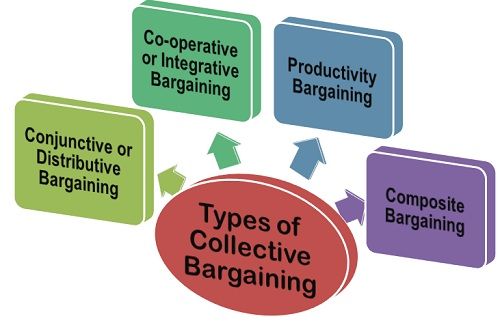Definition: The Collective Bargaining is the process wherein the unions (representatives of employees or workers), and the employer (or their representative) meet to discuss the issues related to wage, the number of working hours, work environment and the other terms of the employment.
There are four types of Collective Bargaining classified on the basis of their nature and the objectives, and can be practiced depending on the different situation requirements.
Types of Collective Bargaining
- Conjunctive or Distributive Bargaining: In this form of collective bargaining, both the parties viz. The employee and the employer try to maximize their respective gains. It is based on the principle, “my gain is your loss, and your gain is my loss” i.e. one party wins over the other.
The economic issues such as wages, bonus, other benefits are discussed, where the employee wishes to have an increased wage or bonus for his work done, whereas the employer wishes to increase the workload and reduce the wages.
- Co-operative or Integrative Bargaining: Both the employee and the employer sit together and try to resolve the problems of their common interest and reach to an amicable solution. In the case of economic crisis, such as recession, which is beyond the control of either party, may enter into a mutual agreement with respect to the working terms.
For example, the workers may agree for the low wages or the management may agree to adopt the modernized methods, so as to have an increased production.
- Productivity Bargaining: This type of bargaining is done by the management, where the workers are given the incentives or the bonus for the increased productivity. The workers get encouraged and work very hard to reach beyond the standard level of productivity to gain the additional benefits.
Through this form of collective bargaining, both the employer and the employee enjoy the benefits in the form of increased production and the increased pay respectively.
- Composite Bargaining: In this type of collective bargaining, along with the demand for increased wages the workers also express their concern over the working conditions, recruitment and training policies, environmental issues, mergers and amalgamations with other firms, pricing policies, etc. with the intention to safeguard their interest and protect the dilution of their powers.
Thus, the purpose of the Collective Bargaining is to reach a mutual agreement between the employee and the employer with respect to the employment terms and enjoy a long term relationship with each other.


Chukwuma Alaohuru says
Your lecture helped me immensely. I’m presently undergoing an Mphil/PhD programme Human Resource Management and there aeems to be dearth of study materials here. But the name of your institution isn’t indicated here. I think it’s good for referencing. Thank you.
Chula anyawu says
Thank you very much
Promise says
Nice work. Your explanations is simple to understand
Jaka Fatty says
Your expectations helps
Aliyu Umar A says
Thanks